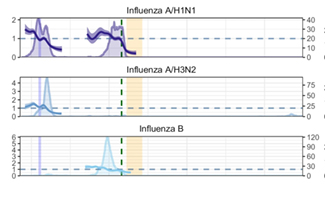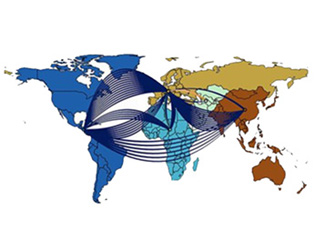Research Roundup: February–May 2024
June 14, 2024
Between February and May 2024, researchers within Fogarty's
Division of International Epidemiology and Population Studies published the following studies on a variety of topics related to domestic and international health.
 Image generated using Adobe Firefly.
Image generated using Adobe Firefly.
People in LMICs are at higher risk of an ICU admission due to flu
Fogarty's Dr. Cécile Viboud and Chelsea Hansen contributed to this report from the Global Influenza Hospital Surveillance Network (GIHSN), which has provided patient-level data on severe influenza-like-illnesses from more than 100 clinical sites since 2012. The team assessed the risk of intensive care unit admission, mechanical ventilation, and in-hospital death among 73,121 patients hospitalized with respiratory illness, including 15,660 with confirmed influenza, in 22 countries. They found a sevenfold increase in the risk of flu-related ICU admission in LMICs, compared with HICs. Influenza mortality increased significantly with older age and number of comorbid conditions, while influenza A/H1N1pdm09 infections proved more severe than A/H3N2.
Heterosexual transmission likely drove the spread of HIV-1 subtype C from Africa to Europe
Fogarty's Dr. Nidia Trovão, senior author, investigated the spread of HIV-1 subtype C, which is thought to have originated in non-human primates in the Democratic Republic of Congo. Despite it being the most prevalent subtype globally, researchers' understanding of its evolution and transmission dynamics remains incomplete. The authors analyzed 1,210 near full-length genomic sequences sampled from 32 countries on four continents with sampling dates between 1986 to 2019. They estimated the total number of introduction events of HIV-1 subtype C between continents and between risk groups to be 71 and 115, respectively. The largest number of introductions occurred from Africa to Europe (n=32), from risk group not recorded to heterosexual risk group (n=40), and from heterosexual risk group to risk group not recorded (n=51).
 Image adapted from Figure 1 of the publication, "Impacts of human mobility on the citywide transmission dynamics of 18 respiratory viruses in pre- and post-COVID-19 pandemic years," Perofsky, A.C., Hansen, C.L., Burstein, R. et al.Daily time-varying effective reproduction numbers (Rt, thick lines, left y-axis) and reconstructed incidences of influenza viruses (thin lines, right y-axis) during November 2018–June 2022.
See full image.
Image adapted from Figure 1 of the publication, "Impacts of human mobility on the citywide transmission dynamics of 18 respiratory viruses in pre- and post-COVID-19 pandemic years," Perofsky, A.C., Hansen, C.L., Burstein, R. et al.Daily time-varying effective reproduction numbers (Rt, thick lines, left y-axis) and reconstructed incidences of influenza viruses (thin lines, right y-axis) during November 2018–June 2022.
See full image.
How mobility influences the spread of respiratory illnesses
Fogarty's Dr. Amanda Perofsky, Dr. Cécile Viboud, and Chelsea Hansen investigated the impact of human behavior on the transmission of 17 common respiratory viruses and SARS-CoV-2 in the greater Seattle, Washington, region over a four-year period, November 2018 to June 2022. The team used detailed data from hospital- and community-based respiratory surveillance in addition to collective movements of mobile device users. A substantial drop in pathogen circulation followed COVID-19 stay-at-home orders in March 2020. During the lockdown period, mobility was a positive, leading indicator of transmission of all viruses except SARS-CoV-2. Once restrictions relaxed, mobility was briefly predictive of SARS-CoV-2 transmission, but this association weakened in subsequent waves. The other common viruses did not rebound concurrently, yet all exhibited stronger, longer-lasting relationships with mobility than SARS-CoV-2.
Assessing the impact of seasonal bird migration and trade on avian flu virus dispersal
Over the past decade, avian influenza virus (HPAIV) A H5 has caused several worldwide outbreaks in domestic poultry, occasional infections in humans, and increasing deaths of wild birds. Fogarty's Dr. Nidia Trovão and her co-authors used wild bird movement tracking data and virus genome sequences to measure how seasonal bird migration facilitates global dispersal of this highly pathogenic virus. The seasonal wild bird migration network is associated with global dispersal and evolutionary dynamics of HPAIV H5, yet inter-regional live poultry trade is not, the team found. These results provide insights into relatively unknown bird orders that may be linked to worldwide spread of HPAIV A H5.
 Image adapted from Figure 6 of the publication, "Contemporary and historical human migration patterns shape hepatitis B virus diversity," Potter BI, Thijssen M, Trovão NS, et al.This graphic shows the spatial transmission dynamics of hepatitis B virus genotype E from 1824 to 2014.
See full image.
Image adapted from Figure 6 of the publication, "Contemporary and historical human migration patterns shape hepatitis B virus diversity," Potter BI, Thijssen M, Trovão NS, et al.This graphic shows the spatial transmission dynamics of hepatitis B virus genotype E from 1824 to 2014.
See full image.
Spread of Hepatitis B subtypes linked to human migration
Fogarty's Dr. Nidia Trovão and her co-authors described 133 newly sequenced hepatitis B virus (HBV) strains from recently arrived African immigrants in Belgium. HBV causes nearly 296 million chronic cases of hepatitis B and roughly 880,000 deaths annually. Severe case distribution is uneven across the globe due to imbalanced circulation of each subtype (each varying in severity and responsiveness to treatment). To launch an effective public health campaign against the virus, the spread of each genotype needs to be characterized. The analyses showed that the A and D genotypes originated in Southeast Asia before spreading across the globe, while the E genotype likely originated in Africa, after which it spread to Europe and the Americas. The prevalence and diversity of HBV subtypes are disproportionately affected by immigration, the authors concluded.
Future scenarios of COVID-19 hospitalizations and deaths in the U.S.
Dr. Cécile Viboud coauthored this COVID-19 Scenario Modeling Hub study, which presents projections of COVID-19 hospitalizations and deaths in the U.S. for the next two years. The authors consider two plausible assumptions about immune escape (20% per year and 50% per year) and three possible CDC recommendations for the use of vaccines (no recommendation, vaccination for those aged 65 years and over, and vaccination for all eligible age groups). In the high immune escape scenario, the hub predicts between 1,438,000 and 4,270,000 hospitalizations and between 139,000 and 461,000 deaths with no vaccination recommendation. In the same scenario, vaccination of those over 65 would result in 230,000 fewer hospitalizations and 33,000 fewer deaths, while vaccination of all eligible people would result in 431,000 fewer hospitalizations and 49,000 fewer deaths, the authors predict.
A new method for combining models to better predict epidemics
Scientists sometimes consolidate predictions from multiple models into "ensembles" to increase the accuracy of their modeling efforts. Fogarty's Dr. Cécile Viboud co-authored this study that proposes a new ensemble procedure for assessing scenario projections. (While "forecasts" predict future outcomes based on current data and trends, "scenario projections" predict future outcomes based on specific conditions that may or may not be realized in the real world.) The Scenario Modeling Hub generated 10 rounds of projections for the trajectory of the COVID-19 pandemic in the U.S. using four distinct scenarios for each round. From these, the authors created a “scenario ensemble" for each round, and then fused these 10 separate ensembles together as "Ensemble2." This approach provided better performance than the scenario ensemble of individual rounds.
Is the U.S. influenza inoculation program effective?
The U.S. experiences a substantial burden of flu mortality despite administering a relatively high number of flu shots. To assess the effectiveness of the U.S. influenza vaccination program, Fogarty's Dr. Cécile Viboud and colleagues estimated population-level effects of influenza vaccination uptake on pneumonia and influenza (P&I) associated deaths. Using publicly available data, they examined links between inoculations and all-age P&I associated deaths in the U.S. from the 2013–2014 season to the 2018–2019 season—a total of 480,111 deaths. Overall influenza vaccine uptake had a statistically significant protective association with the P&I death rate; a significant association was also seen for vaccine uptake in people over 65, but not in those between ages 6 months and 17 years.
Lessons learned from the COVID-19 pandemic
The Center of Excellence in Respiratory Pathogens organized a July 2023 workshop on infectious diseases modelling and lessons learned from the COVID-19 pandemic. Participants, including Dr. Cécile Viboud, discussed multisource data integration and highlighted the benefits of combining traditional surveillance with more novel data sources like mobility data, social media, and wastewater monitoring. Significant advancements were noted in the development of predictive models, with examples showcasing the use of machine learning and A.I. in detecting and monitoring disease trends. Participants advocated for continuing open collaborations and identified a major gap: the absence of a common international framework for data sharing.
Adjacent regions in an American county experienced divergent COVID-19 epidemics
For this study, researchers at the Fred Hutchinson Cancer Center, in collaboration with Fogarty's Drs. Cécile Viboud and Amanda Perofsky, investigated fine-scale SARS-CoV-2 transmission dynamics in King County, Washington. Using SARS-CoV-2 genomes sampled between February 2020 and March 2022, and epidemiological and cell phone mobility data, the team modeled local transmission alongside the rate of outside introductions to understand differences between North and South King County, adjacent regions with stark socioeconomic differences. Following initiation of stay-at-home orders in March 2020, South King showed more cases, COVID-19 hospitalizations, and longer persistence of local transmission compared to North King, where outside viral introductions accounted for a larger percentage of new cases. South King, which bore more socioeconomic inequities, also experienced more modest and less sustained mobility reductions than North King; this may explain the higher rates of local community spread, the authors stated.
How can policy makers best use models of infectious disease outbreaks?
Policy makers increasingly use mathematical models to support their public health planning and outbreak response, but different models often provide dissimilar results. To address this challenge, multi-model hubs convene modeling groups, which generate “ensembles“ that merge several models for a more accurate prediction. Questions remain, among them: How many models are sufficient? The study authors, including Fogarty's Dr. Cécile Viboud, compared multiple model predictions in two contexts: (1) decision settings that depend on quantitative outcome predictions (e.g., hospital capacity planning); and (2) decision settings that require the ranking of alternative epidemic scenarios (e.g., comparing outcomes under multiple possible interventions and biological uncertainties). If only a few models are available, focusing on the rank of alternative epidemic scenarios would be more robust than focusing on quantitative outcomes, the results suggest.
Modeling the threat of mpox importation in mainland China
Fogarty's Dr. Kaiyuan Sun coauthored this study evaluating mpox (monkeypox) importation risk, border screening effectiveness, and local outbreak risk in mainland China. The 2022–2023 mpox outbreak spread rapidly across multiple countries in non-endemic regions, mainly among men who have sex with men (MSM). Using reported mpox cases and international air-travel data, the authors estimated the risk of mpox importation in mainland China from April 14 to September 11, 2022. Reduced international air-travel and a stringent border entry policy decreased mpox importations by about 94% and 69%, respectively, while 15–19% of imported infections would remain undetected under a quarantine policy, the authors estimated. With the recovery of air-travel volume to pre-pandemic levels, mpox could emerge as a public health threat for mainland China, the authors conclude.
More Information
Updated June 14, 2024
To view Adobe PDF files,
download current, free accessible plug-ins from Adobe's website.
Related Global Health Research Topics